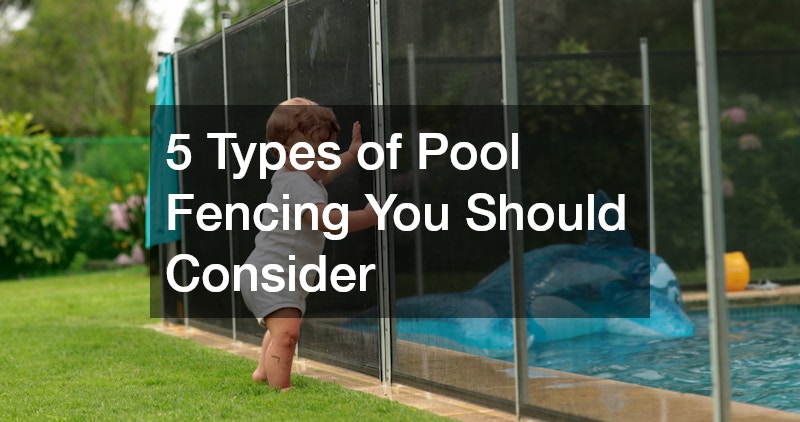Installing a secure and stylish pool fence is one of the most important steps in making your swimming area both safe and visually appealing. Whether you’re upgrading an existing barrier or designing a new pool area, the type of pool fencing you choose will influence safety, privacy, maintenance requirements, and the overall look of your outdoor space. With several materials and styles available, homeowners have plenty of options that cater to various budgets and design preferences.
It’s crucial to understand what each type offers in terms of functionality and compliance with Australian safety standards.
1. Glass Pool Fencing
Frameless or semi-frameless glass fencing has become increasingly popular in modern Australian homes. Its main appeal lies in its sleek and minimalistic design, which provides an uninterrupted view of the pool area. This style enhances the visual space of your backyard and blends seamlessly with contemporary architecture. More importantly, toughened safety glass used in pool fencing is highly durable and resistant to breakage. While installation costs are generally higher than other fencing types, the low maintenance and high aesthetic value often justify the investment. Glass fencing also meets the rigorous safety standards set by Australian regulations, making it a top choice for luxury home designs.
2. Aluminium Pool Fencing
Aluminium is a lightweight, cost-effective, and corrosion-resistant material ideal for pool environments. It is available in a variety of powder-coated colours, allowing for design flexibility to match existing outdoor décor. Unlike steel, aluminium does not rust, which makes it especially suited to coastal areas where exposure to moisture and salt is common. Many homeowners appreciate its ease of installation and minimal upkeep, as it only requires occasional cleaning to maintain its finish. Aluminium fencing offers good visibility and airflow, although it may not provide the same level of visual elegance as glass. Still, for those seeking practical and reliable pool fencing, this option offers excellent value without compromising safety.
3. Steel Pool Fencing
Steel fencing is known for its strength and durability. Galvanised and powder-coated steel options are designed to withstand the harsh Australian climate and provide long-term resistance to rust and fading. This type of fencing is often selected for properties that need extra security or have more traditional architectural features. While heavier than aluminium and more labour-intensive to install, steel offers a more robust barrier, which some homeowners prefer for added peace of mind. Styles such as tubular steel or wrought iron can be customised with decorative elements, lending a classic or heritage look to the pool area. Proper care, including occasional repainting and inspection for corrosion, ensures the fence remains in good condition over time.
4. Timber Pool Fencing
Timber fencing provides a natural, warm aesthetic that integrates beautifully with garden landscapes or rustic property settings. It’s especially popular in suburban homes with lots of greenery or where a softer, more organic appearance is desired. Timber is highly customisable in terms of colour, size, and shape, and can be built to offer complete privacy. However, timber fencing does require more maintenance than metal or glass options, including regular sealing or staining to protect against water damage, rot, and insect activity. Despite these requirements, many homeowners choose timber pool fencing for its charm and ability to create a relaxed, resort-style feel in their backyard.
5. PVC or Vinyl Pool Fencing
PVC, also referred to as vinyl fencing, is a relatively low-maintenance alternative to timber or metal. It is resistant to weather, moisture, and pests, making it ideal for outdoor use. Available in a variety of designs and colours, PVC fencing can mimic the appearance of wood without the upkeep. One of its key advantages is that it doesn’t require painting or staining, and cleaning can typically be done with a garden hose. While it may not have the strength of steel or the elegance of glass, PVC is often chosen for its affordability and longevity. It’s a practical choice for families looking for reliable and child-safe pool fencing that complies with Australian standards.
Making the Right Choice for Your Pool Area
When selecting a pool fence, it’s essential to consider both form and function. The right pool fencing should meet the mandatory safety codes established by local councils, which include minimum height requirements, self-closing gates, and the elimination of climbable objects nearby. At the same time, the fence should align with your aesthetic goals and maintenance expectations. For example, glass and aluminium are ideal for modern homes seeking low maintenance, while timber and PVC may suit more traditional or naturalistic landscaping themes.
Installation and long-term care should also factor into your decision. Some fences require professional installation and periodic maintenance to remain compliant, while others are easier to manage with occasional DIY cleaning or repairs. You should also think about visibility from your home to the pool, as certain fence types—like glass—enhance supervision, which is critical for family safety.
Choosing the right type of pool fencing is not only a matter of personal taste but also a legal and safety requirement across Australia. With options ranging from sleek glass panels to charming timber structures, there is a fencing solution to match every backyard design and budget. The best fence is one that enhances your pool’s appearance, meets all local safety regulations, and suits your lifestyle in terms of maintenance and longevity. By weighing the benefits of each material and design, you can create a safe, stylish, and compliant pool area that adds long-term value to your home.

